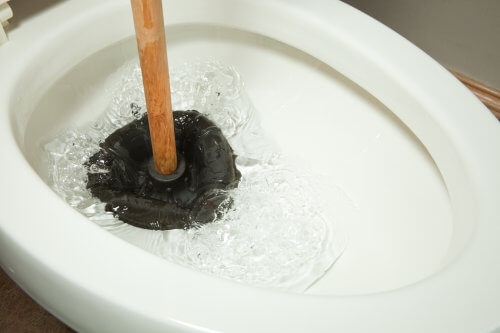5 Ways to Unclog Your Toilet
Nothing says “panic” quite like a clogged toilet. You flush the toilet—the water starts rising and you’re left with mess and an expensive repair bill. In most cases, you can clear a toilet clog with a few tools and a little bit of elbow grease. However, not all toilet clogs are the same. Your toilet could be clogged for many reasons, including:
- Using too much toilet paper
- Flushing non-flushable toiletries
- Dropping toys or other small items in the drain
If your toilet is clogged, and you’re having trouble getting it flowing again, try one of these solutions.
Plunger

Whenever you hear the word clog, your mind probably goes straight to the plunger. If you’re imagining a plunger with a red rubber cup and a long wooden handle, you’re going to have a tough time breaking up the clog. Cup plungers, also known as sink plungers, are used to clear clogs in sinks and other straight drains. To successfully unclog a toilet drain with minimal effort, you need to use a flange plunger. These plungers have an extra rubber ridge at the bottom of the plunger cup that slides into the toilet drain. This creates a better seal and more suction.
Plungers work best when there’s enough standing water in the toilet to cover the cup. Place the flange inside the toilet drain, and press the cup against the drain to form a seal. While maintaining the seal, forcefully push the plunger towards the drain, then pull it back up again. Repeat this motion five times, releasing the cup’s suction on the last pull. Keep repeating this motion until the toilet bowl begins to drain.
Toilet Snake or Closet Auger
Small, hand-powered drain snakes are relatively affordable and available at most local hardware stores. A toilet snake works by breaking up the clog into smaller pieces, so it can pass through the drain.
To use a toilet snake, insert the coiled end into the drain and keep feeding it in until you feel the snake reach the clog. Using the handle, twist the snake until you feel it start to break up the clog. You may need to rotate the snake in the opposite direction, then push forward and begin cranking again, if the clog is large or difficult to break apart. Once the water begins flowing through the drain, you know you’ve removed the clog.
Dish Soap and Hot Water
A combination of dish soap and hot water can help lubricate and break down clogs caused by excess toilet paper use. This trick can also come in handy if you don’t have any toilet unclogging tools close by.
To start, pour approximately one-half cup of liquid dish soap into the toilet bowl. The soap should sink to the bottom of the bowl, making its way down through the water and close to the clog. Let the dish soap rest for 20-30 minutes. Next, fill an old pitcher or gallon-sized container with hot, but not boiling water. Carefully pour the hot water into the toilet bowl, making sure it does not overflow. If successful, water should begin to drain from the toilet bowl. Many have had success using this method overnight, flushing the toilet in the morning.
Baking Soda and Vinegar
Like the dish soap and hot water method of clearing a toilet clog, a concoction of baking soda and vinegar can make your toilet functional again. If you remember building a model volcano in elementary school, combining baking soda and vinegar creates a fizzy, foamy reaction. Unlike corrosive drain chemicals, baking soda and vinegar are completely safe to use and won’t damage your plumbing. A word of caution: if your toilet is close to overflowing, this method could leave you with a big mess to clean up.
Begin by pouring one cup of baking soda into the toilet bowl. Then, add one cup vinegar to the toilet. The baking soda and vinegar will combine, causing an effervescent, fizzy reaction. After the reaction has settled down, pour a generous amount of hot, but not boiling water into the toilet bowl. If successful, the toilet bowl will start to drain.
Wet/Dry Vacuum
Oftentimes, you can unclog a toilet using a wet/dry vacuum like a Shop-Vac. However, NO DOT attempt this method with a regular household vacuum. It is not engineered to handle water.
Use the wet vac to empty the water from the bowl so it doesn’t overflow or splash out. Wrap an old towel or rag around the vacuum hose, and place it up against the toilet drain like a plunger. Apply pressure to the vacuum hose to create the tightest seal that you can. Turn on the vacuum, and listen for the toilet to unclog. If you’re unsure, turn off the vacuum and see if the toilet begins to drain.
Toilet Tips
- Don’t use chemical drain cleaners. These solutions can damage your plumbing and septic systems.
- Keep an eye on the water level. A clogged toilet is inconvenient, but an overflowing toilet is an even bigger mess.
- Close the toilet lid. Many clogs happen when the lid is open and an item falls off the lid of the toilet tank into the bowl.
If you’ve tried all five methods, and your toilet is still plugged up, call Bailey Brother Plumbing at 405-896-9988. Our experts have the tools and skills to get any toilet flowing again.
